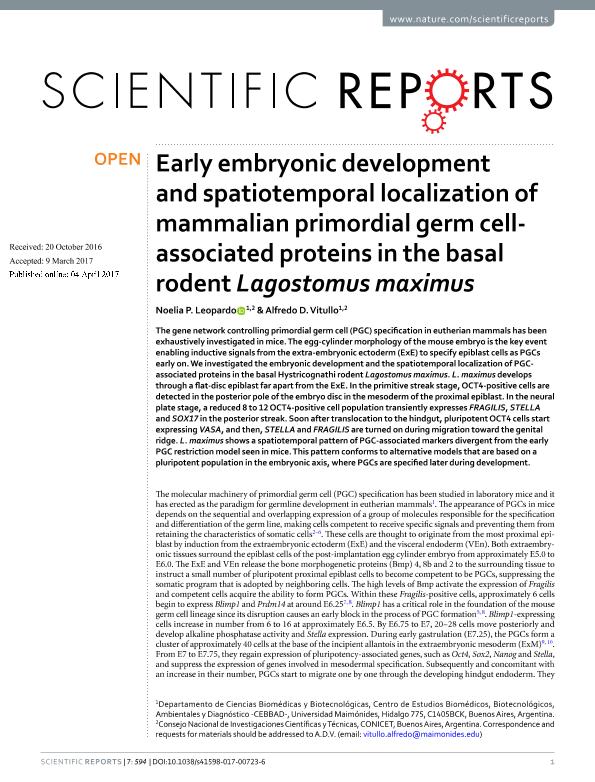Artículo
Early embryonic development and spatiotemporal localization of mammalian primordial germ cell-associated proteins in the basal rodent Lagostomus maximus
Fecha de publicación:
12/2017
Editorial:
Nature Publishing Group
Revista:
Scientific Reports
ISSN:
2045-2322
Idioma:
Inglés
Tipo de recurso:
Artículo publicado
Clasificación temática:
Resumen
gene network controlling primordial germ cell (PGC) specification in eutherian mammals has been exhaustively investigated in mice. The egg-cylinder morphology of the mouse embryo is the key event enabling inductive signals from the extra-embryonic ectoderm (ExE) to specify epiblast cells as PGCs early on. We investigated the embryonic development and the spatiotemporal localization of PGC-associated proteins in the basal Hystricognathi rodent Lagostomus maximus. L. maximus develops through a flat-disc epiblast far apart from the ExE. In the primitive streak stage, OCT4-positive cells are detected in the posterior pole of the embryo disc in the mesoderm of the proximal epiblast. In the neural plate stage, a reduced 8 to 12 OCT4-positive cell population transiently expresses FRAGILIS, STELLA and SOX17 in the posterior streak. Soon after translocation to the hindgut, pluripotent OCT4 cells start expressing VASA, and then, STELLA and FRAGILIS are turned on during migration toward the genital ridge. L. maximus shows a spatiotemporal pattern of PGC-associated markers divergent from the early PGC restriction model seen in mice. This pattern conforms to alternative models that are based on a pluripotent population in the embryonic axis, where PGCs are specified later during development.
Palabras clave:
Primordial Germ Cells
,
Pgc Specification
,
Rodents
,
Lagostomus Maximus
Archivos asociados
Licencia
Identificadores
Colecciones
Articulos(SEDE CENTRAL)
Articulos de SEDE CENTRAL
Articulos de SEDE CENTRAL
Citación
Leopardo, Noelia Paola; Vitullo, Alfredo Daniel; Early embryonic development and spatiotemporal localization of mammalian primordial germ cell-associated proteins in the basal rodent Lagostomus maximus; Nature Publishing Group; Scientific Reports; 7; 1; 12-2017; 1-11
Compartir
Altmétricas




